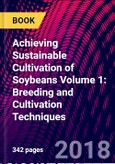Soybeans are one of the most widely-grown crops in the world. As the world’s main source of vegetable protein, they have a wide range of food and non-food uses. Current yields need to increase significantly to meet growing demand but in a way that reduces input use, does not damage the environment and is resilient to climate change. This collection reviews the wealth of research addressing this challenge. Volume 1 focuses on breeding and cultivation techniques. Part 1 starts by reviewing our understanding of soybean physiology and genetic diversity. It then discusses advances in conventional and marker-assisted breeding, as well as transgenic techniques, and their use to produce more stress-resistant varieties. Part 2 reviews key advances in cultivation techniques to make the most of these new varieties. With its distinguished editor and international team of authors, this will be a standard reference for soybean scientists, growers, government and non-government agencies supporting soybean cultivation. It is accompanied by a companion volume that looks at diseases and pests as well as the crop's range of uses.
Audience: Soybean scientists; soybean growers; government and non-governmental agencies supporting soybean cultivation
Audience: Soybean scientists; soybean growers; government and non-governmental agencies supporting soybean cultivation
Table of Contents
Part 1 Plant physiology and breeding1. Advances in understanding soybean physiology and growth: M. B. Zhang and X. T. Chu, Centre for Integrative Legume Research, University of Queensland, Australia; H. N. Su, University of Queensland, Australia, and National Navel Orange Engineering Research Center, Gannan Normal University, China; A. H. Hastwell, P. M. Gresshoff and B. J. Ferguson, Centre for Integrative Legume Research, University of Queensland, Australia;
2. Maintaining and utilizing the genetic diversity of soybeans: Randall Nelson, USDA-ARS and University of Illinois, USA;
3. Advances in conventional soybean breeding techniques: E. E. Large, E. Beche, D. Mutoni and A. Scaboo, University of Missouri, USA;
4. Mapping the soybean genome: Xiaobo Wang, Anhui Agricultural University, China; and Lijuan Qiu, Chinese Academy of Agricultural Sciences, China ;
5. Advances in marker-assisted breeding of soybeans: T. Vuong, University of Missouri, USA; and D. Walker, USDA-ARS and University of Illinois, USA ;
6. Advances in genetic modification of soybeans: Wensheng Hou, Chinese Academy of Agricultural Sciences, China;
7. Advances in the drought and heat resistance of soybean: Heng Ye, Babu Valliyodan, Li Song, J. Grover Shannon, Pengyin Chen and Henry T. Nguyen, University of Missouri, USA;
8. Towards improving the salt tolerance of soybean: Ailin Liu, Wai-Lun Cheung, Wai-Shing Yung, Carol Lee, Fuk-Ling Wong, Kit-Wah Siu and Hon-Ming Lam, Center for Soybean Research of the Partner State Key Laboratory of Agrobiotechnology and School of Life Sciences, The Chinese University of Hong Kong, Hong Kong SAR, China;
9. Advances in flood-tolerant varieties of soybean: C. Wu and W. Hummer, University of Arkansas, USA; P. Chen, G. Shannon, H. Ye and H. T. Nguyen, University of Missouri, USA; G. Kaur and J. Orlowski, Mississippi State University, USA; T. Carter, USDA-ARS, USA; and B. Buckley, Louisiana State University, USA;
Part 2 Cultivation techniques
10. Modelling the effects of temperature and photoperiod on soybean reproductive development: H. Yang, University of Nebraska, USA ;
11. Defining and implementing best management practices in soybean production: Daniel B. Reynolds, Mississippi State University, USA;
12. Sustainable soybean production research and practice: contrasting case studies from three soybean production areas: Roger W. Elmore, Rodrigo Werle and Charles Wortmann, University of Nebraska, USA; Phinehas Tukamuhabwa, Makerere University, Uganda; and Nathan Mueller, University of Nebraska, USA;
13. Supporting smallholders in soybean cultivation: the example of Zimbabwe: Byron Zamasiya and Kefasi Nyikahadzoi, University of Zimbabwe, Zimbabwe








